How Do You Evaluate A Press Release?
There are several factors to consider when evaluating a press release. You need to take note of the timing of the release and whether it is relevant to your audience. If the press release is not timely, it may not be relevant to your audience.
Additionally, you should look at the overall quality of the writing and design. A well-written and designed press release will make a better impression on your audience.
When evaluating a press release, accuracy is vital. Ensure the release’s information is correct before distributing it to your audience. You don’t want to mislead them with inaccurate information.
Most importantly, you should determine if the press release will likely generate media coverage. Media coverage depicts the reach to which your press release appears.
Media coverage could be in the form of traditional media (newspapers, magazines) or new media (social media, websites, blogs). However, there exists different metrics to determine your reach.
4 Critical Metrics for Evaluating Press Release Success
You can assess the effectiveness of your press release using a number of important measures. These metrics include
1. Number of media placements – This measures how many times your press release has been published in the media. The more placements you have, the more successful your release has been.
2. Media reach – This measures how many people have been exposed to your press release. The more people see your release, the more successful it has been.
3. Number of social shares – This measures how many times your press release has been shared on social media. The more shares you have, the more successful your release has been.
4. Conversion rate – This measures how many people who read your press release take the desired action. The higher your press release conversion rate, the greater your chances of achieving success with your PR.
Categorization of Press Release Quality
The content of a press release is considered as good, average, or poor on the following basis:
1. Clarity of headline: A good headline is clear and concise. In contrast, an average headline and lead (introductory paragraph) are only adequate. On the other hand, a poor headline is confusing or hard to understand.
2. Degree of newsworthiness: A good press release contains information that is new, interesting, and relevant to the audience. An average press release may contain some new information that is not particularly interesting or relevant. A poor press release contains old or irrelevant information.
3. Quality of writing: A good press release is well-written and easy to read. An average press release is adequate but may contain errors. A poor press release is poorly written and difficult to read.
4. Journalistic style: A good press release is written in a journalistic style. This means it is objective and free of marketing language. An average press release may contain some marketing language, but it is not excessive. A poor press release is full of marketing language and is biased.
5. Grammar and syntax: A good press release is free of grammar and syntax errors. An average press release may contain some errors, but they are not excessive. A poor press release is full of grammar and syntax errors.
Final Thoughts
When evaluating a press release, it is important to consider a number of factors. These include the accuracy of the information, the timeliness of the release, the overall quality of the writing and design, and the likelihood of media coverage. Considering all of these factors ensures that you are making the best decision for your company.
Featured Image – Megapixl © Ivelinr











